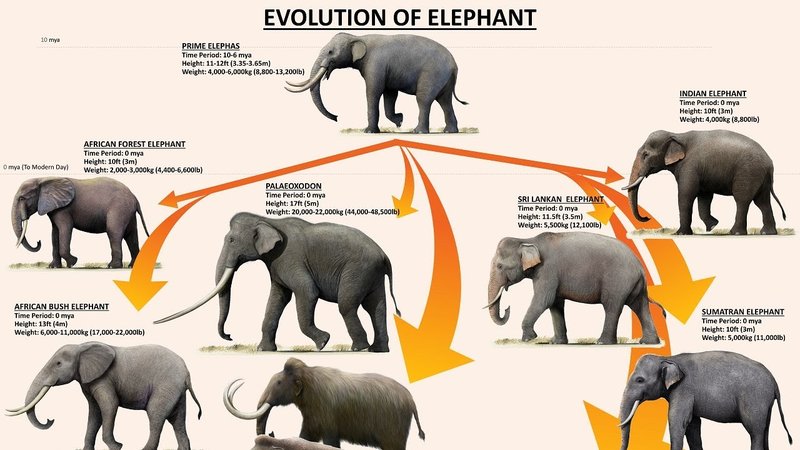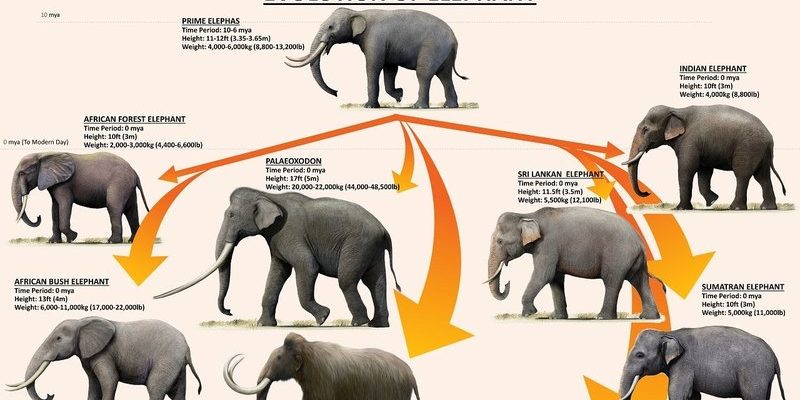
Imagine the African elephant as a time traveler, adapting to its environment while carrying a rich history of evolution on its back. This evolution is not just about physical changes; it’s about survival, environmental shifts, and the impact of human activities. So, let’s dive deep into this enthralling saga and explore how the African elephant transformed over time into the iconic creature we know today.
Origins of Elephants: A Brief Overview
Before we dive into the specific evolutionary journey of the African elephant, it helps to understand where it all began. Elephants, as we know them, belong to the family Elephantidae. Their ancestors can be traced back to around 60 million years ago, during the Eocene epoch. At that time, early elephants were quite different from what we see today. They were smaller and had more elongated bodies.
The story truly picks up during the Miocene epoch, about 23 to 5 million years ago. This period saw the emergence of several elephant-like species that roamed various parts of the world. One of them was Mastodon, which had long tusks and a robust body. It’s fascinating to think that these ancient beings thrived in various climates, showcasing the adaptability that would later be a hallmark of their descendants.
As time went on, the proboscideans (the order that includes modern elephants and their relatives) began to branch out into various lineages. The two most well-known are the African elephants and the Asian elephants. However, it’s the African elephant that has a particularly captivating evolutionary tale.
Two Distinct Species: African Forest and African Savanna Elephants
One of the key points in the evolutionary history of the African elephant is the development of its two distinct species: the African forest elephant and the African savanna elephant. While they share a common ancestor, they adapted differently to their environments.
African forest elephants (Loxodonta cyclotis) are smaller and have straighter tusks, perfectly suited for the dense, wooded habitats of Central and West Africa. Meanwhile, the African savanna elephant (Loxodonta africana), the largest land animal on Earth, roams the open grasslands and savannahs. Its larger size and broader ears help it regulate body temperature in hot climates.
These adaptations didn’t happen overnight. Over millions of years, both species developed specialized physical traits that allowed them to thrive. For instance, the forest elephant’s smaller stature allows it to maneuver through thick tree cover, while the savanna elephant’s size enables it to forage for food over vast distances. Honestly, it’s a beautiful example of how nature shapes life on Earth.
The Role of Climate Change
You might be wondering how climate change fits into the story of elephants. Well, climate has played a crucial role in shaping their evolution. Throughout history, Africa has experienced significant climatic shifts—sometimes becoming wetter and more forested, at other times drier and more savanna-like.
During these changes, elephants adapted to their surroundings. When the climate became more arid, the savanna elephants thrived, developing adaptations like larger bodies to travel longer distances in search of food and water. Conversely, forest elephants adapted to the cooler, humid conditions of the dense jungle, resulting in their unique traits.
These adaptations were not just about survival—they were essential for the elephants’ continued prominence on the continent. The fluctuations in environment led to evolutionary pressure that shaped the different species we see today. It’s a reminder that evolution is not a straight line; it’s a winding path filled with twists and turns influenced by changing conditions.
Interactions with Humans: A Complicated History
As fascinating as the evolutionary history of the African elephant is, it’s equally important to discuss their interactions with humans. For thousands of years, elephants and humans have coexisted, with both positive and negative repercussions.
In ancient times, elephants were revered in various cultures. They were often associated with royalty and strength. However, as human populations grew, the relationship became more complicated. Habitat destruction, hunting, and poaching for ivory became significant threats to their survival. Seriously, when you think about it, the impact humans have had is staggering.
Historically, elephants have also adapted to living alongside humans. Some communities have developed practices to coexist with these majestic creatures, while others have seen conflict arise over land and resources. This dynamic is yet another layer in the evolutionary history of the African elephant. Their ability to navigate these changes, while still holding on to their essence, is nothing short of remarkable.
Conservation Efforts: A Future for Elephants
Currently, the story of the African elephant isn’t just about evolution; it’s also about survival. Conservation efforts are crucial to ensure that these magnificent animals continue to roam the Earth. With both species, the African forest and savanna elephants, facing various threats, numerous organizations are working tirelessly to protect their habitats and reduce human-wildlife conflicts.
Many conservation programs focus on education, helping local communities understand the importance of elephants and the roles they play in the ecosystem. Elephants help maintain the environment by creating clearings in forests and dispersing seeds, which contributes to plant biodiversity.
Additionally, anti-poaching initiatives are vital. By raising awareness about the dangers of poaching and illegal ivory trade, we can help protect these elephants and preserve their legacy. Here’s the thing: Every effort counts. Whether it’s supporting a local conservation project or simply learning more about these animals, each step can help ensure a future where elephants continue to thrive.
The Importance of Elephants in Ecosystems
Finally, let’s talk about why the evolution of the African elephant matters. Elephants aren’t just big animals; they play a crucial role in their ecosystems. By feeding on a wide variety of plants, they help shape the landscape. As they roam, they create paths through dense vegetation, allowing other animals to move and access resources. Their droppings even act as a natural fertilizer, promoting plant growth and contributing to nutrient cycling.
This means that when we protect elephants, we’re not just preserving a species; we’re supporting an entire ecosystem. Their presence is a key indicator of a healthy environment. So, understanding their evolutionary history isn’t just about the past; it’s about the future of our planet.
In conclusion, the evolutionary history of the African elephant is a captivating tale of adaptation and survival. From ancient ancestors to modern-day giants, these animals have undergone incredible changes shaped by their environment and human influence. As we continue to learn and grow as a species, let’s not forget the importance of preserving these majestic creatures and the ecosystems they support. After all, their story is intertwined with ours, and it’s up to us to ensure they have a future on this planet.

